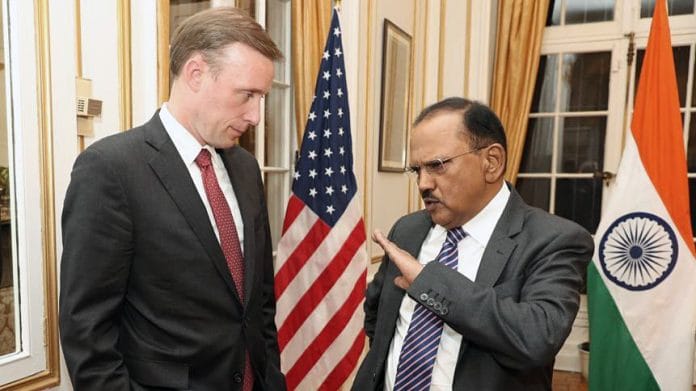New Delhi: National Security Advisor Ajit Doval pushed for greater technology transfer in the defence and space domain during his talks with American counterpart Jake Sullivan in Washington this week, and insisted on deliverables in a time-bound manner.
Sources in the defence and security establishment said key projects which came up for discussion included Transfer of Technology (ToT) for jet engines, long-range precise artillery munitions and Stryker-armoured personnel carriers.
They added the plan was to get projects going in a time-bound manner and that both countries would come together to manufacture in India through public and private partnerships that will be helmed by the government.
Doval and Sullivan formally launched the US-India Initiative on Critical and Emerging Technologies (iCET) on Tuesday.
The iCET was announced in May 2022 by US President Joe Biden and Prime Minister Narendra Modi to elevate and expand bilateral strategic technology partnership and defence industrial cooperation between the governments, businesses, and academic institutions of the two countries.
Sources described the iCET as an opportunity for both countries to work together in a deeper sense. From the US perspective, they said, the idea was not just to work closely with India but also to wean away New Delhi’s dependence on Russia for its defence needs.
A statement released by the White House said the meeting focussed on developing a new bilateral Defense Industrial Cooperation Roadmap to accelerate technological cooperation between both countries for joint development and production, with an initial focus on exploring projects related to jet engines, munition-related technologies, and other systems.
The statement also said the US would expeditiously review an application from General Electric to jointly produce jet engines that could power jet aircraft operated and produced indigenously by India.
Both NSAs also agreed on enhancing long-term research and development cooperation, with a focus on identifying maritime security and intelligence surveillance reconnaissance (ISR) operational use cases, besides launching a new “Innovation Bridge” that will connect US and Indian defence startups.
According to sources, Doval highlighted the need to convert intentions and ideas into actions and specific deliverables through focussed steps in a time-bound manner.
They said the ball was in the US court as far as cooperation was concerned since ToT decisions and other cooperation issues — even between private companies — have to be decided by the American administration.
Doval also met with US Deputy Defense Secretary Dr Kathleen Hicks. Pentagon spokesman Eric Pahon, in a readout of the meeting, said Hicks reiterated that building alliances and partnerships was a top priority for the department, and integral to the ongoing implementation of the US National Defense Strategy.
He added the meeting discussed priorities for the US-India bilateral defence partnership — strengthening policy and operational coordination in the Indo-Pacific region and increasing defense industrial cooperation between the two countries.
Much discussion also took place for cooperation in the space domain. Incidentally, the NASA-ISRO Synthetic Aperture Radar (NISAR) mission is planned to be launched in 2024. This mission is expected to systematically map Earth, using two different radar frequencies to monitor resources such as water, forests and agriculture.
The mission will provide important Earth science data related to ecosystems, Earth’s surface, natural hazards, sea-level rise and the cryosphere, the state department said in a statement.
Also read: Fits between Tejas & heavier fighters — Why Lockheed wants India to buy F-21






